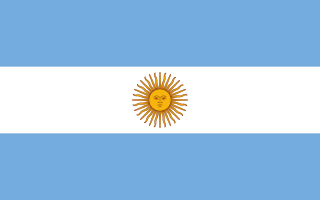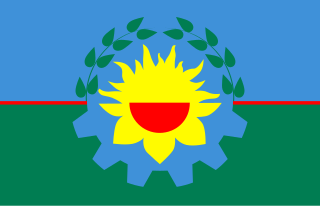 W
WThe flag of Argentina is a triband, composed of three equally wide horizontal bands coloured light blue and white. There are multiple interpretations on the reasons for those colors. The flag was created by Manuel Belgrano, in line with the creation of the Cockade of Argentina, and was first raised at the city of Rosario on February 27, 1812, during the Argentine War of Independence. The National Flag Memorial was later built on the site. The First Triumvirate did not approve the use of the flag, but the Asamblea del Año XIII allowed the use of the flag as a war flag. It was the Congress of Tucumán which finally designated it as the national flag, in 1816. A yellow Sun of May was added to the center in 1818.
 W
WThe flag of the Andes was a flag used by Argentine patriot José de San Martín and his Army of the Andes during their famous Crossing of the Andes and their subsequent military campaigns to Chile and Peru. The flag of the Andes was personally designed by San Martín and sewn by ladies from the Cuyo region and wives of San Martín's officers. It includes a proto-coat of arms of Argentina placed horizontally over a sky-blue and white bicolor background.
 W
WThe flag of Buenos Aires Province, Argentina, was created by students and officially adopted by Provincial Law 11.997 on August 12, 1997, after being chosen among other designs by vote of the educative community in which 270,000 students aged 12–18 took part in over 2 years, supported by specialists and parents. There were 81,525 proposals, 32 of which were selected from all 16 regions along 1995–96. 4 of the final 32 were selected by a jury to be voted on by 2 million students on 12 August 1997. The flag was designed by the boys of Schools Matheu Gelicich and Faustino Sarmiento, chosen by 1,500,000 voters, garnering over half the vote.
 W
WThe flag of Buenos Aires was originally designed in 1580, but it was officially adopted on October 24, 1995. It shows the coat of arms of the House of Habsburg, as the flag has an eagle on a white background. The use of Habsburg symbols comes from Charles V of the Habsburg dynasty, who was king of Spain when Buenos Aires was originally founded in 1536. The city was eventually abandoned, but it was refounded in 1580, during the reign of Charles V's son, Philip II.
 W
WThe flag of Macha is the name given to a pair of flags of Argentina found at a chapel in the hamlet of Titiri, near the village of Macha, north of Potosí, Bolivia. They are considered to be the first physical flags created by Manuel Belgrano, who in November 1813 hid the standards to prevent them from falling into enemy hands. They were discovered in 1885. Bolivia kept one of those flags at Sucre; the other was given to Argentina in 1896 and is currently kept at the National Historical Museum. Tucumán Province has used it as provincial flag since 2010. The flag preserved in Argentina is a triband of blue, white and blue bands, like the modern flag of Argentina, but the one kept in Bolivia is a triband of white, blue and white.
 W
WOctober 8 marks the day of the flag of Salta, Argentina, in recognition of the creation of the province in 1814, when Gervasio Posadas, Supreme Director of the United Provinces of the Río de la Plata, issued the decree that established the creation of the Governor of Salta. That act was unrelated to the government of Tucumán and became a province, also shaped by the territory of Jujuy Province, Oran, Tarija, and Santa Maria.
 W
W